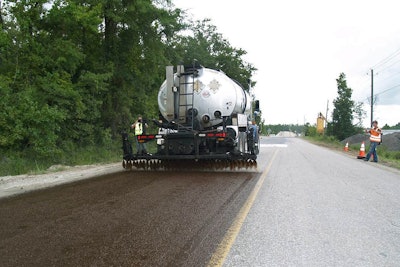
Pavement preservation methods extend pavement life, avoiding high future costs of reconstruction or rehabilitation through the expenditure of lesser amounts of money at critical points in a pavement’s life. Such methods include surface treatments such as chip seals and slurry surfacings including micro surfacing, all of which utilize asphalt emulsions to preserve pavements.
For years, application of pavement preservation treatments has focused on low-volume streets and roads in both urban and rural applications, and the pavement maintenance contractor has been a prime driver in this work.
But in the last two years, as the discipline of pavement preservation has matured, the “hot button” emphasis of preservation research has migrated from low-volume rural lanes and urban streets, to higher-volume four-lane and interstate highways.
In 2016, lessons learned from long-standing preservation of low-volume roads are being applied to extension of service life of higher-traffic volume highways. Buttressed by active research from a SHRP2 project, R26: Preservation of High-Traffic-Volume Roadways, the FHWA is publicizing the benefits of select pavement preservation treatments for these critical highways.
This year, emphasis on preservation of high-volume pavements is accelerating with ongoing research at the National Center for Asphalt Technology, where preservations treatments were placed last summer on four-lane, divided highway U.S. 280 in Alabama. This year, similar treatments will be placed on I-94 at the MnROAD Road Research Facility of the Minnesota DOT north of Minneapolis. The performance of these southern- and northern-climate installations will be monitored for years.
Lower Volume Leads Mileage
With all this interest in high-volume pavement preservation, it’s time to go back to the basics of preservation of low-volume pavements. That’s because although high-volume roads carry most traffic, low-volume roads – generally defined as roads with less than 1,000 average annual daily traffic (ADT) – account for 82 percent of total U.S. lane mileage.
Experience shows that spending a dollar on pavement preservation can eliminate or delay spending $6 to $10 on future rehabilitation or reconstruction costs. Because approximately two-thirds of these low-volume roads are paved, considerable savings can be realized locally, statewide and nationwide when preservation is undertaken.
The savings can lead to success. For example, Oregon’s Low Volume Road Preservation Program maintains state highways with an average daily traffic (ADT) of less than 5,000 vehicles and 20-year equivalent single axle truck loads (ESALs) of less than 3 million. This program was launched in 1999 with only regional and district level highways with an ADT of less than 1,000 vehicles, but following successes, was expanded to roads with 2,500 ADT in 2005, and to 5,000 ADT in 2009.
Texas DOT’s pavement preservation program started earlier, having been launched in 1987 with the TxDOT Preventive Maintenance Program, funded at $145 million annually for preventive maintenance projects.
Today, TxDOT requires each district to produce an annual Four-Year Pavement Management Plan that includes all aspects of pavement-related work. These are project-specific and financially constrained plans which map out the pavement work needed, along with expected changes in pavement condition.
There is money in preservation of roads, and maintenance contractors are part of it. In its 2015-2019 Strategic Plan, TxDOT reported that 40 percent of the TxDOT biennial budget ($8.6 billion) was dedicated to system preservation.
TxDOT accomplishes its maintenance mission by effectively supplementing its work force with routine maintenance contracts and preventive maintenance contracts. The state processes approximately 1,400 maintenance contracts a year, with an average contract approximately $90,000, and several contracts exceeding $1 million. The average duration is 1 year with variation from 45 days to 2 years. Contracts estimated at under $300,000 account for about 75 percent of the contracts.
Emulsions for Preservation
Texas shows that in light of limited budgets, preservation of pavements is a powerful tool for governments to use to prolong system life, and contracted services are one way they can expand preservation programs. Fortunately, governments and contractors can choose from a variety of practical pavement preservation treatments which utilize asphalt emulsions for bituminous-surfaced roads
“Seventy percent of all problems that develop with asphalt pavements can be attributed to the oxidation of oils in the asphalt binder, and water penetration,” said Tammy Sims, P. E., area engineer, Paris District of TxDOT. “Water, through chemical reaction and the freeze-thaw cycle, is asphalt pavement’s greatest enemy, causing the breakdown of the pavement structure. These problems can be virtually eliminated with a conscientious and timely program of carefully selected surface treatments utilizing asphalt emulsions.”
An asphalt emulsion for surface treatments is a homogeneous mixture of two insoluble substances, oil and water. In it particles of liquid asphalt (the dispersed phase) are surrounded by molecules of water (the continuous phase).
Asphalt emulsions are produced by dispersing tiny globules of asphalt cement into water treated with a small quantity of emulsifying agent. The dispersion takes place in a powerful blender, called a colloid mill, where spinning blades break or shear the liquid asphalt into suspended microscopic particles. The water, or soap solution, is immediately introduced to form the emulsion. These globules are either anionic (negatively charged) or cationic (positively charged).
The emulsifier – an engineered surfactant (detergent) or surface-active agent – maintains the microscopic asphalt droplets in a stable suspension, keeping them from recombining. The amount and type of surfactant used, along with other variables, controls properties of the emulsion critical to performance in the field application.
Generally speaking, an emulsion will be constituted of 57 to 70 percent typical range of asphalt binder content per ASTM specifications, with the rest water and a very small amount of emulsifier, sometimes as low as one quarter of a percent by weight. The emulsifier also partially controls the “break” time following placement on a road, in which the water evaporates, leaving the residual asphalt behind.
Residual asphalt is the remaining asphalt after an emulsion has cured, typically 57 to 70 percent. The bond or tack coat break is the moment when water separates enough from the asphalt emulsion showing a color change from brown to black.
The chemistry of asphalt emulsions enable excellent coating and adhesion of the residual asphalt cement to aggregate surfaces in both dense and open-graded mixes, base stabilization, and stockpiled patching mixes. They’re also economical where small quantities of mix need to be produced at locations remote from asphalt plants, or when environmental issues make use of HMA difficult.
Variety of Treatments
A variety of treatments using asphalt emulsions is available for just about every pavement preservation application.
The chip seal is an economical surface treatment in which the pavement is sprayed with emulsified asphalt and then immediately covered with aggregate and rolled. On low-volume roads chip seals are used primarily to seal the surface of a pavement with non load-associated cracks, and to improve surface friction.
Long-term pavement performance studies show that chip seals are one of the most cost-effective means of pavement preservation, especially for low-volume pavements. A modified chip seal is a variation in which the asphalt emulsion is modified with polymer modifiers – or fibers or a blend of ground tire or latex rubber – to enhance the elasticity and adhesion..
Sand seals describe a light application of asphalt emulsion binder, which is covered with a fine aggregate. This is followed by a tractor pulling a broom sled which works the material into cracks. Sand seals improve the skid resistance of slippery pavements, and seal them against air and water intrusion.
With value-added scrub seals, application procedure of the emulsion is paramount. Scrub seals involve application of a polymer modified asphalt emulsion to the pavement surface, followed by a broom trailer which forces the emulsion into cracks and voids. After brooming, an even coat of sand or small aggregate is placed, and a second brooming of the aggregate and asphalt mixture follows. This seal is then rolled with a pneumatic tire roller. Both sand and scrub seals are swept before opening to traffic.
An emulsion preservation treatment need not have aggregate applied at all. A fog seal is a light application of slow-setting asphalt emulsion diluted with water, but without the addition of any aggregate applied to the surface of a bituminous pavement. Fog seals are used to renew aged asphalt surfaces, seal small cracks and surface voids, or adjust the quality of binder in newly applied chip seals.
Fog seals are an inexpensive way of covering large surface areas. They can be applied using conventional distributors and should be spread as evenly as possible to achieve optimum coverage and penetration of surface cracks. The application rate ranges from 0.1 to 0.15 gal./s.y. of diluted emulsion, typically diluted with water by 25 to 75 percent.
A double chip seal is a preservation treatment that consists of application of asphalt emulsion and a large aggregate, followed by a second application of asphalt emulsion that is, in turn, covered with smaller aggregate and compacted.
Sandwich seals are used to seal the surface and improve skid resistance, especially on asphalt pavement surfaces that are bleeding or flushing.
A slurry is a mixture of a liquid and fine solid particles that together are denser than water. A slurry seal is a mixture of slow-setting emulsified asphalt, well-graded fine aggregate, mineral filler, and water. The treatment seals and waterproofs the surface, fills minor cracks, restores skid resistance and restores aesthetic appeal with a black surface, all at a relatively low cost. The slurry surface is smoother than that of a chip seal. Slurry seals extend the life of existing pavements by protecting the undersurface from the effects of aging and the environment.
Slurry seals are available in three types, depending upon the average size of the aggregate. Generally, Type I is used to seal surface cracks on low-volume roadways; Type II is used to correct raveling and oxidation on roadways with moderate to heavy traffic levels; and Type III is used to fill minor surface irregularities and restore surface friction.
Slurry seals cure primarily through water evaporation, so they should not be placed in thicker lifts than recommended. Traffic should not be reintroduced until the seal has thoroughly cured, which may take two to eight hours, depending on the ambient conditions. Slurry seals are not appropriate for pavements with rutting (more than ¼ in.) or high severity surface distresses.
For rutted pavements and high performance surfaces on heavily traveled pavements, micro surfacing is an excellent treatment. A micro surfacing is a laboratory-specified mixture of polymer modified asphalt emulsion, mineral aggregate, mineral filler, water, and other additives, properly proportioned, mixed, and spread on a paved surface using specialized equipment. Micro surfacing differs from slurry seal in that it can be used on high volume roadways to correct wheel-path rutting and provide a skid-resistant pavement surface.
A cape seal is a surface treatment in which a slurry seal or micro surfacing is applied to a newly constructed surface treatment or chip seal. Cape seals are used to provide a dense, waterproof surface with improved skid resistance and ride quality.
For more information about asphalt emulsions and pavement preservation for low volume roads, visit the Asphalt Emulsion Manufacturers Association at www.aema.org.




![[VIDEO] Timelapse of Erection of Liebherr 710 HC-L on NYC MoMA Tower Project](https://img.forconstructionpros.com/files/base/acbm/fcp/image/2016/01/default.56a939680811b.png?auto=format%2Ccompress&fit=crop&h=167&q=70&w=250)
![[VIDEO] Helicopter Tour Over Ritchie Bros. Heavy Equipment Orlando Auction](https://img.forconstructionpros.com/files/base/acbm/fcp/image/2016/01/default.56a8ce7ae735d.png?auto=format%2Ccompress&fit=crop&h=167&q=70&w=250)













